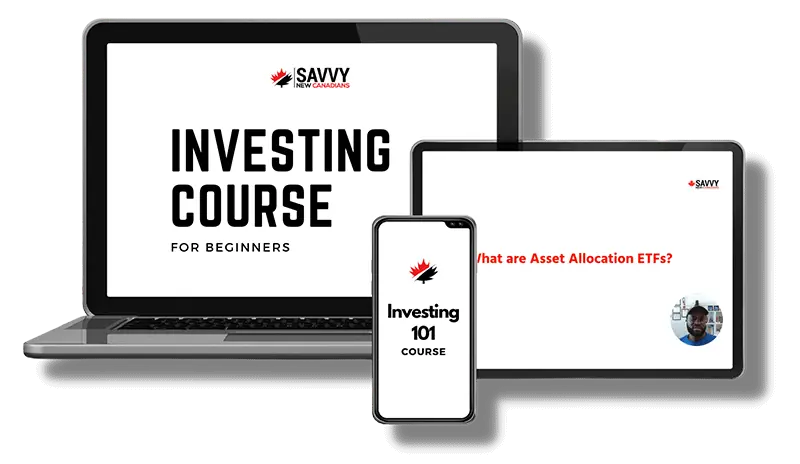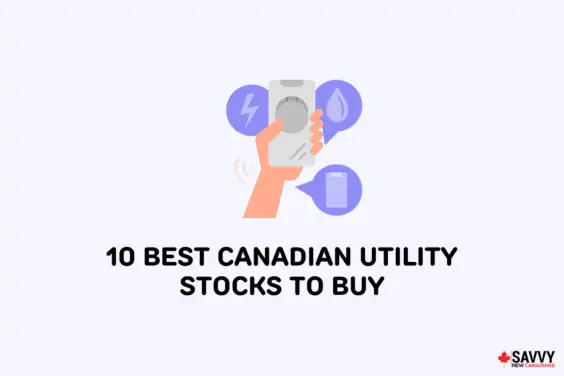The iShares Core S&P/TSX Capped Composite Index ETF (XIC) invests in hundreds of Canadian companies, capturing approximately 95% of the Canadian stock market.
The low management fees and exposure to various Canadian industries make XIC one of the best ETFs for Canadians who want to focus their portfolio on the domestic market.
Listed on the Toronto Stock Exchange, XIC can be purchased through commission-free trading platforms like Wealthsimple Trade and Questrade.
This XIC review covers its holdings, performance, fees, pros and cons, and how it compares to similar ETFs like VCN, XIU, ZCN, and XEQT.
What is XIC?
The iShares Core S&P/TSX Capped Composite Index ETF, or XIC, is an exchange-traded fund (ETF) managed by Blackrock Canada.
This ETF holds many Canadian companies with the goal of replicating the performance of the S&P/TSX Capped Composite Index.
Being capped means that while bigger companies have larger weighting within the ETF, none of them can exceed a weighted allocation of 10%.
XIC holdings are rebalanced quarterly to ensure that this cap is maintained. This rebalancing ensures that the ETF’s performance is not impacted too much by one or two large companies.
In total, the ETF holds 232 companies which represent 95% of the entire Canadian equities market.
As a result, the ETF is often used as a gauge of how the Canadian market as a whole is doing.
For investors looking for broad exposure to Canadian companies in various sectors, the XIC ETF is a great option.
Some key facts about XIC (as of May 4, 2023) are:
- Inception date: February 16, 2001
- Number of holdings: 232 holdings
- Net assets: $9.045 billion
- 12-month trailing yield: 3.07%
- Distribution yield: 3.19%
- Management fee: 0.05%
- Management Expense Ratio (MER): 0.06%
- Eligible accounts: Registered and non-registered accounts
- Listing currency: CAD

XIC Asset Holdings
XIC holds 232 companies representing over 90% of the Canadian stock market.
Listed on the Toronto Stock Exchange, XIC is designed for Canadian investors who want to focus their investments specifically on the Canadian economy.
The top 10 holdings as of May 2023 were:
| Company Name | Stock Ticker | Weighted Allocation in XIC |
| Royal Bank of Canada | RY.TO | 6.18% |
| Toronto Dominion | TD.TO | 5.05% |
| Enbridge Inc | ENB.TO | 3.65% |
| Canadian Pacific Kansas City | CP.TO | 3.40% |
| Canadian National Railway | CNR.TO | 3.32% |
| Canadian Natural Resources Ltd | CNQ.TO | 2.88% |
| Bank of Montreal | BMO.TO | 2.86% |
| Bank of Nova Scotia | BNS.TO | 2.68% |
| Shopify Class A | SHOP.TO | 2.57% |
| Brookfield Corp Class A | BN.TO | 2.04% |
As this list shows, XIC holdings are full of well-known Canadian companies. Broken down by sector, the top XIC sector holdings are:
- Financials (29.87%)
- Energy (16.55%)
- Industrials (13.79%)
- Materials (13.02%)
- Information technology (6.66%).
Without geographic diversification, the ETF is very dependent on the performance of the Canadian economy.
This makes the ETF riskier compared to more globally diversified funds.
Those who believe in Canadian companies and the ability of the Canadian economy to outperform other countries would find the XIC ETF a good investment opportunity.
XIC ETF Returns and Performance
The XIC ETF was established in 2001, and its performance has been fairly consistent since its inception. XIC has returned 341.62% since it started trading over twenty years ago.
This means that if you had invested $10,000 when XIC was listed, your account would now be valued at approximately $34,162.
Not surprisingly, 2022 was a tough year for XIC. The fund returned a loss of -5.85% to investors during the heart of the global bear market. Still, over the past three years, XIC has returned 15.11% and 9.04% over the past five.
Over the entire 20-plus-year period since the fund’s inception, returns equated to an average of 6.92% annually.
XIC Dividends
XIC distributes dividends every quarter.
As of May 4th, 2023, the dividend distribution is 3.19%, with a 12-month trailing yield of 3.07%.
XIC ETF Fees
The XIC ETF charges a management fee of 0.05% and a management expense ratio (MER) of 0.06%. This means that for every $10,000 you invest in XIC, you will pay fees of $6 annually.
You can easily purchase XIC using a commission-free platform like Questrade and pay no trading commissions.
Compared to the average equity mutual fund that costs up to 2% per year, an ETF like XIC can help you cut your investment fees to the bone.
It is also cheaper than a robo-advisor (approx. 0.70%) since you don’t need to pay extra management fees for someone to manage your portfolio on your behalf if you use a self-directed account.
That said, self-directed trading means you have to manually rebalance your portfolio when required, and you won’t get access to free financial advice.
Pros:
- Low fees compared to other similar ETFs.
- Capped structure means that poor performance from one company will not dramatically impact the ETF’s price.
- Easily purchase commission-free on Wealthsimple Trade or Questrade and gain exposure to the entire Canadian market without the need to pick individual stocks.
Cons:
- A lack of geographic diversification means more risk in the event of an economic downturn in Canada.
- Heavily weighted in a small number of industries (financials, energy, and industrials make up over 50% of the fund).
- It may not be suitable for risk-averse investors
XIC vs. XIU
The iShares S&P/TSX 60 Index ETF (XIU) tracks the performance of the S&P/TSX 60 index. The two ETFs are very similar, with both being managed by Blackrock Canada.
The main difference between the two is that XIU focuses on the top 60 companies in Canada, while XIC focuses more broadly on the entire Canadian stock market.
XIC also charges slightly higher fees, with a 0.15% management fee and 0.18% management expense ratio (compared to 0.05% and 0.06% for XIC, respectively).
As of May 4, 2023, the dividend yield is slightly higher for XIU at 3.32% with a trailing 12-month yield of 3.03%.
XIC vs. VCN
A very similar fund to XIC is the Vanguard FTSE Canada All Cap Index ETF (VCN). The fund tracks the performance of the FTSE Canada All Cap Domestic Index, which consists of small, medium, and large-sized Canadian companies.
The main difference between the two is that VCN does not have a cap on weight, meaning larger companies can represent a larger proportion of the overall fund.
As of March 31st, 2023, the fund held 184 different companies. The MER for VCN is a very reasonable 0.05% with an annualized distribution yield of 3.21%.
XIC vs. ZCN
BMO S&P/TSX Capped Composite Index ETF (ZCN) is a fund that aims to replicate the S&P/TSX Capped Composite Index. Just like XIC, ZCN invests in the top Canadian companies listed in the Canadian stock market.
The top 10 holdings for both ETFs are identical, and the performance of the two ETFs is very similar.
Both ETFs also charge the same management fee and management expense ratios. ZCN has a slightly higher distribution yield at 3.32%.
XIC vs. XEQT
iShares All-Equity ETF (XEQT) is a Blackrock-managed ETF that’s holdings consist of other ETFs also managed by Blackrock. Close to 25% of XEQT holdings are XIC, meaning a quarter of the ETF’s performance is dependent on how well XIC performs.
The fund’s largest holding is ITOT (44.24%), which is the US-listed iShares Core S&P Total US Stock Market ETF.
This gives XEQT more geographic exposure compared to the Canadian-centric XIC.
With a large portion of the ETFs holdings in non-Canadian companies, XEQT would perform well even if the Canadian markets performed poorly.
XEQT has an MER of 0.20% and a current dividend yield of 1.36% which is paid out every quarter.
How To Buy XIC ETF in Canada
XIC is an ETF listed on the Toronto Stock Exchange. To purchase XIC, simply open an account using one of the many brokerage platforms available to Canadians.
For those looking for low-fee platforms that are user-friendly, Wealthsimple and Questrade are both great options.
Questrade
Questrade offers free purchases for many Canadian ETFs and stocks but does charge a small commission when selling.
Overall, the platform is easy to use and gives traders access to a wide range of stocks, ETFs, foreign currency, options, and bonds.
New users of Questrade can sign up here and get a $50 trading fee credit when they deposit at least $1,000 in their account.
Questrade

Trade stocks, ETFs, options, FX, bonds, CFDs, mutual funds, etc.
Get $50 trade credit with $1,000 funding
Low and competitive trading fees
No quarterly inactivity fees
Access to advanced tools and trading data
Top platform for advanced traders
Transfer fees waived
Wealthsimple Trade
Wealthsimple Trade is a popular Canadian brokerage platform that offers zero-commission trading on Canadian stocks and ETFs.
Buying and selling XIC on this platform is as simple as looking up the symbol, selecting your desired number of shares, and placing the trade.
For new users, a $25 cash bonus is available through our exclusive promo link after depositing at least $150 within 30 days of registration.
Wealthsimple Trade

Trade stocks and ETFs for free
Great trading platform for beginners
$25 cash bonus when you deposit $200+
Transfer fees waived up to $150
Is XIC a Good Investment?
XIC is a good option for investors who want to have broad exposure to Canadian markets.
Since the fund was created, investors have been rewarded with consistent year-to-year returns. However, past performance is not a guarantee for future returns.
Investors who believe the Canadian economy will outperform other global economies are likely to find that XIC is a good investment.







